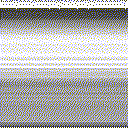
(may take a min. to load)
|
Multimedia Demonstration
The animated clip to the
left shows how a CT machine reconstructs a "slice" of something,
in this case the human head. The clip begins showing just
one projection of the image, a collection of horizontal lines -
this can be thought of as representing the various densities of
the head (similar to a shadow - where the brain is denser there
are more "shadows"). As more projections are made
at different angles, represented by the animation twisting around,
and they are combined together, we can start to see the form of
the human head reconstructed from all of these projections.
Once the image has been completed
twisted around we can recognize the image, but it is very
fuzzy. In order to correct this problem, we must filter the
image to remove the unwanted "noise." This final
step is shown in the movie clip where we finally see the image
become sharp - we have now created a "slice" of the
human head without any mess.
|
|